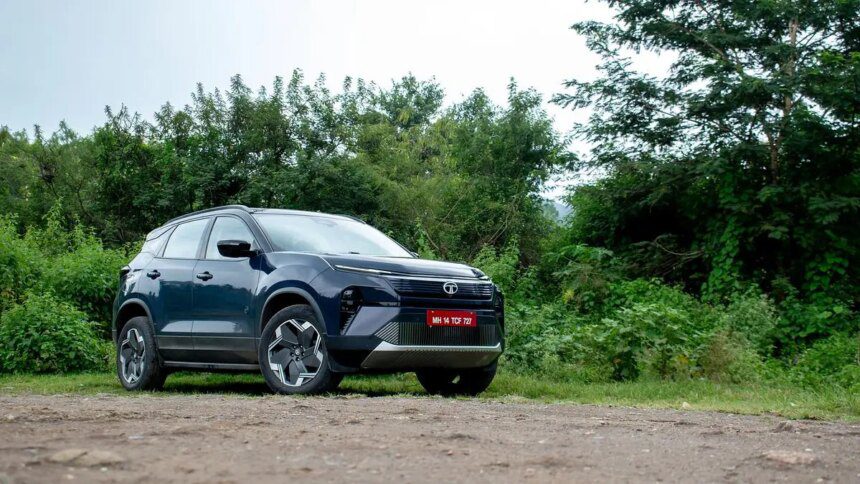Tata Harrier. ev | Photo Credit: Ishaan Jaiswal
I drove normally, overtaking when necessary and maintaining legal speeds. Being an electric vehicle, regeneration plays a big role, and on the Pune-to-Mumbai stretch — where you descend from the Deccan Plateau to sea level — the Harrier. ev recuperated a fair amount of energy. By the time I reached Mumbai, the battery was at 68 per cent, meaning I’d used 32 per cent of the charge for nearly 180 km. That’s genuinely impressive for a 2.3-tonne SUV. Charging was just as straightforward; plugged into a 150 kW fast charger, the Harrier EV charged to 100 per cent in around 27 minutes.
Right from the moment you get inside, the Harrier. ev feels like Tata’s flagship product. Over the years, Tata has faced criticism for inconsistency in build quality, but this SUV feels like a complete turnaround. The cabin is silent, solid, and free from any unwanted rattles — exactly what you’d expect from a premium EV. At the centre of the dashboard sits a large Samsung-sourced infotainment screen. The 12.3-inch screen provides sharp visuals and quick responses, serving as the command hub for most vehicle functions. While many controls have moved to the touchscreen, Tata has retained key physical buttons for essentials such as climate control and defogging — a small but appreciated touch for usability.
well seated
The Harrier EV also offers a Level 2 ADAS suite for enhanced safety and driver assistance. For convenience, there’s an HD rear-view mirror paired with a 360-degree camera system that also includes a transparent bonnet view, allowing the driver to see obstacles hidden directly in front of the car — especially useful during off-road driving. Rear seat passengers get comfortable headrests and sunshade curtains, adding to the SUV’s premium feel.
Safety is another strong point, with seven airbags offered as standard. The Harrier EV also features Boost Mode and Off-Road Assist, along with six terrain modes — Normal, Snow/Grass, Mud/Ruts, Sand, Rock Crawl and Custom. In addition, it includes an Acoustic Vehicle Alert System (AVAS) for pedestrian safety, 65W USB Type-C fast-charging ports for quick device charging, and full over-the-air software-update support. Wireless smartphone connectivity is also available, ensuring seamless integration of your digital life with the vehicle.
The front seats offer excellent cushioning and support, while the rear seats are spacious and plush. A clever design detail borrowed from aviation — tilt-adjustable rear headrests — adds long-distance comfort. The panoramic sunroof floods the cabin with light, and the sound insulation ensures that conversations happen in near silence. Altogether, the Harrier EV AWD offers a thoroughly modern and well-rounded feature set.
The Harrier EV AWD packs a 75 kWh battery powering two electric motors — one on each axle. The front motor produces 156 bhp, while the rear develops 235 bhp, with a combined torque output of 51.39 kg-m. Together, they provide seamless power delivery and strong traction when you need it most. Tata claims a range of 622 km for the top QWD variant, with real-world numbers between 460–490 km depending on your driving style.
Acceleration is brisk yet refined. There’s no drama, no torque steer — just a strong, linear surge of power. One thing that stood out was how composed it felt under hard acceleration — unlike many EVs that simply spin their wheels, the Harrier EV puts its power down cleanly and stays perfectly in control. The absence of engine noise, combined with instantaneous torque, makes overtakes effortless. The Harrier EV doesn’t try to be a performance SUV, but it’s surprisingly quick for its size, always feeling composed and confident.
One of the highlights of the car is how planted and balanced it feels. The placement of the battery pack lowers the centre of gravity, improving stability and cornering behaviour. Around sweeping bends or when changing lanes at high speeds, the SUV remains composed with minimal body roll — quite impressive for something this tall. The suspension tuning strikes an excellent balance between firmness and comfort. Even over monsoon-ravaged roads, the Harrier EV rides with calm authority. It doesn’t feel unsettled, and the cabin remains isolated from road imperfections.
While some might wish for a more radical design — as seen with global EVs — Tata’s decision to keep it conservative and familiar is intentional. For many customers transitioning from petrol or diesel cars, familiarity breeds comfort. The Harrier EV looks premium yet approachable, modern yet unmistakably a Harrier. Living with the Harrier EV feels reassuringly normal — and that’s the point. You don’t need to adjust your lifestyle dramatically to accommodate it.
Despite being loaded with tech, the Harrier EV never feels intimidating to operate. Everything works intuitively, and the overall refinement level is impressive. Compared to the diesel Harrier, this EV feels far more sophisticated. It’s the first Tata SUV that feels globally competitive in execution. With the Harrier EV, Tata Motors has built confidence in itself, its technology, and the future of Indian electric mobility.
© Motoring World
Published on October 10, 2025










